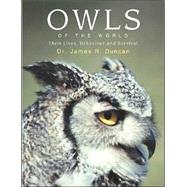
James R. Duncan, PhD, is an ornithologist and a member of the National Science Council of Bird Studies.
| Foreword | |
| Preface | |
| Introduction | |
| The Nature of Owls Feathers | |
| Structure and Function | |
| Color Variations in Owls | |
| Reversed Sexual Size Dimorphism | |
| Vision Eye and Skull Structure | |
| The Owl Eye in More Detail Ears and Hearing Feet, Toes and Talons Digestion | |
| Owl Pellets | |
| Owl Hunting and Caching Behavior | |
| Behavior | |
| Breeding | |
| Strategies | |
| The Classification of Owls | |
| The Evolution of Owls | |
| The Range Limits of Owls | |
| Biogeography | |
| Invited contributions | |
| What's in a Name? | |
| DNA Sequencing and the Classification of Owls | |
| Discovery of a New Owl Species | |
| The Sumba Hawk Owl | |
| Strangers in the Dark: Hybridization between Owl Species | |
| Owls in Mythology and Culture | |
| Introduction | |
| Symbols Old and New Markers of Gods, Knowledge, Dread, Wisdom and Fertility | |
| The Spirit Chasers | |
| Owls in Literature and Paintings | |
| Towards a Tolerant Conservation | |
| Conclusion | |
| The Study of Owls | |
| Owl Behavior Population Dynamics | |
| Predator-Prey Studies | |
| Owl Pellets and Diet Studies | |
| Nesting Biology | |
| Owl Banding | |
| Longevity Records | |
| Calculating Longevity | |
| A Sample of Owl Studies | |
| Invited contributions | |
| Female Desertion in Southern Boobooks | |
| To Catch an Owl | |
| The Snowy Owls of Wrangle Island | |
| Snowy Owl Migrants in New England | |
| The Mystery of the Asio Owls on the Saskatchewan Prairies | |
| Color Variation in Owls: Albinism and Melanism | |
| Threats to Owls Accidents | |
| The Perils of Flight Road | |
| Mortality Pesticides, Shooting and Trapping Predation and Competition | |
| Habitat Loss Invasive Alien Species Owls in Captivity | |
| The Threat of "Postmodern" | |
| Conservation Strategies Ignorance as a Threat Invited contributions | |
| Causes of Owl Mortality in Canada | |
| The Plight of Burrowing Owls in Winter | |
| Salvaged Bounty | |
| Owl Ectoparasites | |
| A World for Owls | |
| Introduction | |
| Invited contributions | |
| Adventures with Saskatchewan Great Horned Owls | |
| Precious Moments | |
| Why Filming Owls is Worth the Effort | |
| The Ural Owls and Forest Management in Japan | |
| A Conservation Solution | |
| A Wilderness Experience | |
| Studying the Backcountry Boreal Owl | |
| Bringing Back the Barn Owl in Ontario | |
| Remaining Choices | |
| Understanding the Needs of Injured Owls | |
| Conclusion | |
| Owls of the World | |
| Their Global Conservation Status and General Distribution | |
| A brief summary of 205 owl species, some with photographs and identified by the owl's common and scientific name | |
| Each summary includes: Description Habitat and Range | |
| Map Conservation Status | |
| List of Contributors | |
| Selected Bibliography | |
| Acknowledgements | |
| Index | |
| Table of Contents provided by Publisher. All Rights Reserved. |
The New copy of this book will include any supplemental materials advertised. Please check the title of the book to determine if it should include any access cards, study guides, lab manuals, CDs, etc.
The Used, Rental and eBook copies of this book are not guaranteed to include any supplemental materials. Typically, only the book itself is included. This is true even if the title states it includes any access cards, study guides, lab manuals, CDs, etc.